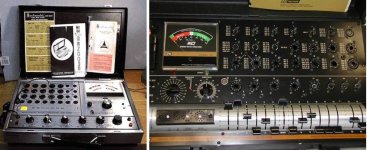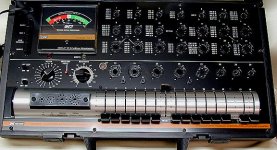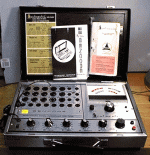HollowState said:2 Tektronix 570 curvetracers (late round corner versions w/5K+ S/Ns)
Two? I have one Tek 570, and that was hard work dragging it home on the train.
I also have an AVO VCM163. Four independent faults had to be fixed before it measured gm. (Two were genuine faults, two were faults added by the previous investigator who had given up in disgust, thrown all the cover panels away, and splashed "U/S" across the front in orange paint.)
I seem to accumulate British testers
One each Avo Mk1,Mk2,Mk3,Mk4
An Avo VCM163 (my favourite)
An Avo CT160
A couple of Taylor 45Cs
A New London Instrument 901 transconductance analyser
(weighs a heap)
And a couple of ancient US relics for display only.
M
One each Avo Mk1,Mk2,Mk3,Mk4
An Avo VCM163 (my favourite)
An Avo CT160
A couple of Taylor 45Cs
A New London Instrument 901 transconductance analyser
(weighs a heap)
And a couple of ancient US relics for display only.
M
This was a tube tracer which I built -- it used a BasicStampII to send the data into MicroSoft Excel (for those of you who still remember serial ports) -- you could test 2 tubes at the same time, or 2 halves of a triode and look at the different performance in real time.
The power supply was a Heath that I gutted out and built a programmable HV supply.
The power supply was a Heath that I gutted out and built a programmable HV supply.
An externally hosted image should be here but it was not working when we last tested it.
EC8010 said:
I also have an AVO VCM163. Four independent faults had to be fixed before it measured gm. (Two were genuine faults, two were faults added by the previous investigator who had given up in disgust, thrown all the cover panels away, and splashed "U/S" across the front in orange paint.)
I hope you hunted him down and did real bad things to him...
(hums "Trueblood" theme)
M
mobyd said:I hope you hunted him down and did real bad things to him...
He/she was a transmitter engineer, so it wasn't necessary. I've noticed that long-term workers at HF transmitters are all a bit, well, dim.
John Broski http://www.tubecad.com/ has published a few circuits recently toward a modern tube tester. There are one or 2 DIY tube testers around.
I started with a Taylor 45D I found in the dumpster behind the Physics building at the University of South Australia - it cost me A$50 (US$40) to get the operator and service and tube data manuals and about 4 hours one winter Saturday afternoon to get it going.
The Taylor is a great little unit and very easy to use but I found that it did not run output tubes at high enough current and they read low gm as a result.
I have recently "splashed out big" and bought an AVO MKIII. It cost me A$1000 (US$800) but I would'nt be without it. This unit was originally owned by a local television station and still has an "NWS Channel 9" logo on it.
I also have a "museum" piece. A Hickok with "Bacchus Marsh Repeater Station - 1945" on the case. This is a bit of Ozzie history, used on the original Australian overland telegraph. It works but generally just sits on the shelf and looks pretty.
Cheers,
Ian
I started with a Taylor 45D I found in the dumpster behind the Physics building at the University of South Australia - it cost me A$50 (US$40) to get the operator and service and tube data manuals and about 4 hours one winter Saturday afternoon to get it going.
The Taylor is a great little unit and very easy to use but I found that it did not run output tubes at high enough current and they read low gm as a result.
I have recently "splashed out big" and bought an AVO MKIII. It cost me A$1000 (US$800) but I would'nt be without it. This unit was originally owned by a local television station and still has an "NWS Channel 9" logo on it.
I also have a "museum" piece. A Hickok with "Bacchus Marsh Repeater Station - 1945" on the case. This is a bit of Ozzie history, used on the original Australian overland telegraph. It works but generally just sits on the shelf and looks pretty.
Cheers,
Ian
I have two, a Sencore MU150 (can test a lot of tubes) and a B&K 747 (on the right). The MU150 (on the left) measures the tube conductance using an actual waveform, not just a static voltage. It is called ''Mutual Dynamic Conductance''. Suppose to be a more accurate way of getting the number right. It has a HV tube rectifier and an actual tube amplifier. Works great.
The B&K is fully solid state. Work well as well.
The B&K is fully solid state. Work well as well.
Attachments
I had many tube testers... I only kept those on which I have found some usefulness or reliability in operation and tube condition diagnosis !
All of them are restored and calibrated, in perfect operating condition. Here they are pictured on my bench :
Each of them has his advantages and drawbacks :
The 539C has the most complete features for tube testing : Gm, life expectancy, interectrode leaks, regulator tests... He is considered as the epitome of the tube testers, but the reality is somewhat different : he states minimum Gm values reject points, and not the expected "in specs tube" Gm values... Moreover, many direct heating tubes like 2A3, 300B can't be tested, and despite having a Compactron socked, most of these tubes requires the use of a CA-4 or CA-5 external adaptor that I don't have.
The 600 is interesting because it measures the Gm in average values, and after making numerous tests on "exacty in specs" tubes, I noticed that these tuse displayed the AVG value of the roll chart. Of course, his checking features are simplified.
If I want to make more accurate and reliable measurements, my Metrix 310CTR is THE tube tester. Unlike the Hickok and most of the US tube testers, he makes tube measurements under the tube manufacturer's datasheet conditions, that is to say real measurements, but won't be able to give me interelectrode leaks or shorts informations as good as the 539C.
For a quick tube sorting, the portable, lightweight National Radio Instrument is perfect. It will tell me if a tube is still alive, dying or dead, but won't tell me about its working condition.
The small SECO GCT-5 is intended to test grid leak on tube preamps... He is the exception, since he is still in "as is" condition, and I'm not sure that it works correctly or is even able to give any serious indication...
If I really want to go further, I make a bench test using regulated power supplies, audio generators, U and I AC and DC meters... For example to test 211/VT4C or 6336A/B tubes.
A+!
All of them are restored and calibrated, in perfect operating condition. Here they are pictured on my bench :
An externally hosted image should be here but it was not working when we last tested it.
Each of them has his advantages and drawbacks :
The 539C has the most complete features for tube testing : Gm, life expectancy, interectrode leaks, regulator tests... He is considered as the epitome of the tube testers, but the reality is somewhat different : he states minimum Gm values reject points, and not the expected "in specs tube" Gm values... Moreover, many direct heating tubes like 2A3, 300B can't be tested, and despite having a Compactron socked, most of these tubes requires the use of a CA-4 or CA-5 external adaptor that I don't have.
The 600 is interesting because it measures the Gm in average values, and after making numerous tests on "exacty in specs" tubes, I noticed that these tuse displayed the AVG value of the roll chart. Of course, his checking features are simplified.
If I want to make more accurate and reliable measurements, my Metrix 310CTR is THE tube tester. Unlike the Hickok and most of the US tube testers, he makes tube measurements under the tube manufacturer's datasheet conditions, that is to say real measurements, but won't be able to give me interelectrode leaks or shorts informations as good as the 539C.
For a quick tube sorting, the portable, lightweight National Radio Instrument is perfect. It will tell me if a tube is still alive, dying or dead, but won't tell me about its working condition.
The small SECO GCT-5 is intended to test grid leak on tube preamps... He is the exception, since he is still in "as is" condition, and I'm not sure that it works correctly or is even able to give any serious indication...
If I really want to go further, I make a bench test using regulated power supplies, audio generators, U and I AC and DC meters... For example to test 211/VT4C or 6336A/B tubes.
A+!
Last edited:
- Status
- Not open for further replies.
- Home
- Design & Build
- Equipment & Tools
- Vacuum tube tester, do you own one?



